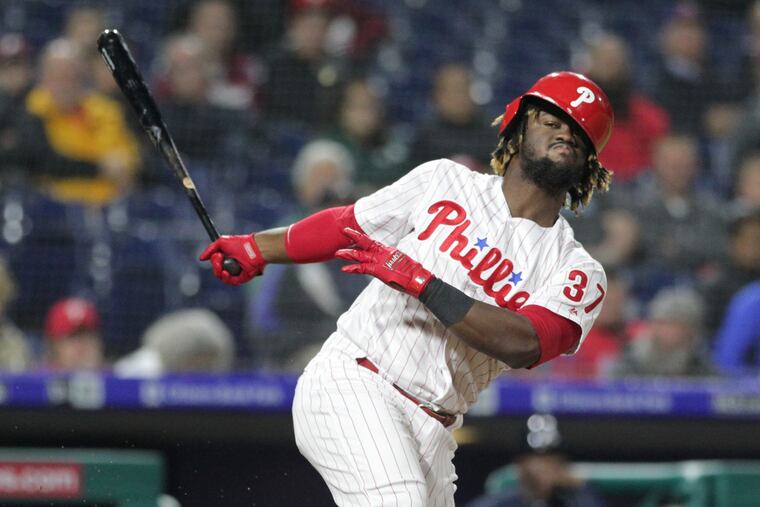Odubel Herrera’s impact on the Phillies will be felt even in his absence | Scott Lauber
While the rival New York Mets were able to recoup money on the contract of oft-injured Yoenis Cespedes and reinvest it in their roster, the Phillies don't have such recourse as Odubel Herrera returns from a suspension.

The long odds of Odubel Herrera ever getting another at-bat for the Phillies became almost infinitesimal this week with his removal from the 40-man roster.
Just don't bet against him having an impact on the team this year, even in his absence.
By designating Herrera for assignment, the Phillies have seven days to trade him, release him, or outright him to the minors. For now, given Herrera’s salary and the coinciding lack of interest around baseball, Option C seems to be the most likely outcome. If nothing else, he will be mostly out of sight, a millionaire castaway in minor-league camp at spring training.
But Herrera is still a dues-paying member of the MLB Players’ Association, and as such, he’s protected from having his contract voided after a May 27 arrest on charges of assaulting his girlfriend in an Atlantic City casino hotel. (A judge dismissed the case in July after the alleged victim declined to press charges, but Major League Baseball suspended Herrera without pay for the final 85 games of the season.)
So, unless another team loses its mind and trades for Herrera, or Herrera loses his and requests his release rather than accepting a minor-league assignment, the Phillies are on the hook for his salary this year ($7.35 million) and next ($10.35 million), in addition to his $2.5 million buyout for 2022. And that's no small thing for a team with a payroll that is pushed up against the $208 million luxury-tax threshold like a bug on a windshield.
If they’re being honest, Phillies officials would concede they probably need another starting pitcher and a couple of relievers to overtake the two-time division champion Atlanta Braves and the World Series-winning Washington Nationals. But with an estimated payroll of $203 million, as calculated for luxury-tax purposes according to Cot’s Baseball Contracts, signing a Rick Porcello (one year, $10 million), Kevin Gausman (one year, $9 million), or Dellin Betances (one year, $10.5 million) would have put them into tax territory, a place that ownership appears unwilling to go until it knows the Phillies have a real chance at the National League East crown.
Herrera counts for $6.1 million against the luxury tax whether he plays for the Phillies this season or not, leaving general manager Matt Klentak to likely rue the day in December 2016 that he conferred upon him a five-year, $30.5 million contract extension -- or at least wish that Herrera’s demise was more like, say, outfielder Yoenis Cespedes’ problems with the rival New York Mets.
Cespedes suffered a season-ending right ankle fracture last May in an off-field incident and didn’t play at all last season. But because of the nature of the accident -- the New York Post reported that Cespedes stepped into a hole after an interaction with a wild boar at his ranch in Port St. Lucie, Fla. -- the Mets got him to agree to restructure his four-year, $110 million contract. They recouped at least $15.7 million, savings that dropped their luxury-tax number from $216.7 million to $187 million, according to Spotrac.
With more room to maneuver beneath the tax threshold, the Mets were able to sign Porcello and Betances, among others.
The Phillies have no such recourse with Herrera, who likely will toil away on the back fields of the Carpenter Complex this spring while his former teammates tune up for the season within earshot at Spectrum Field. It’s possible that he could begin the season in the minors, too. Or the Phillies could release him and give him a chance to sign elsewhere, a scenario that would still require them to pay all but the major-league minimum portion of his salary and keep them in the vice of the luxury tax.
“It hasn’t played out exactly how we would have hoped,” Klentak said Tuesday night of Herrera’s contract, speaking from a baseball perspective.
On the field, a lot could have gone wrong in the Phillies’ multiyear union with Herrera, especially considering he signed the deal after only two big-league seasons. Herrera’s play dropped off after the All-Star break in 2018. Always a streaky hitter, he didn’t rebound in April or May last year, either. Since the middle of the 2018 season, he batted .217 with a .625 on-base plus slugging percentage.
In his stead last season, he was surpassed in center field by both 23-year-old prospect Adam Haseley and oft-injured Roman Quinn. The final push off the 40-man roster came when the Phillies signed Nick Martini, a lefty-hitting outfielder with major-league experience and a chance at winning a bench job. In essence, he replaced Herrera in the organization.
But Klentak was candid about whether Herrera would have fallen so far down the depth chart if not for his absence due to the suspension.
"It's impossible to project what might have happened in an alternate universe," Klentak said. "I'm not sure."
All but certain, though, is the Phillies’ owing Herrera the rest of the money on his contract, which might clinch their eventual need to push the payroll over the luxury tax or risk another season out of the playoffs.